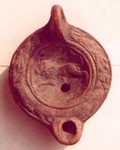Since the day of its birth, Rome was immersed in the artistic creativity of the Etruscan world which surrounded it. Its conquest of southern Italy and in particular of Tarento in 272 B.C. exposed its citizens to Greek art for the first time. When the Romans occupied Greece in 197 B.C., they were dazzled by the wonders that they discovered and brought back to Rome, and they would adopt with enthusiasm the Greek criteria of beauty. Many Greek statues are known to us only through their Roman copies.
Always pragmatic, the Romans attracted artists from the whole world around them, and they put to skillful use the lessons from all the peoples they dominated. From those foundations there emanated a characteristically original Roman art in its own right.
In their architecture for example, the Romans combined the Etruscan concept of the vault and the Greek style columns. Their invention of a highly resistant concrete-like binding material, gave them a free hand in bringing to fruition their extravagant tastes in impressive construction works . The decoration of their buildings demonstrated a mastery of the art of bas-relief, painting (as appears in Pompeii), and sculpture....
 ...but Roman art celebrated neither the gods as the Greeks did, nor everyday life in the Etruscan style: it celebrated the power of Rome and the Romans. While the Greeks carved idealistic portraits, the Romans carved, and engraved on their coinage much more realistic likenesses. Even though mythological topics were still appreciated and represented, architecture and sculpture also represented a political art for propaganda purposes.
...but Roman art celebrated neither the gods as the Greeks did, nor everyday life in the Etruscan style: it celebrated the power of Rome and the Romans. While the Greeks carved idealistic portraits, the Romans carved, and engraved on their coinage much more realistic likenesses. Even though mythological topics were still appreciated and represented, architecture and sculpture also represented a political art for propaganda purposes.
 Rich Romans appreciated luxury and ostentatious design in their everyday lives, as expressed in the wall paintings, the frescos. They invented optical illusions (3-D "trompe l'oeil") and mosaics. They were masters in glassware, silverware, jewellery and cameos, and especially in bronze working, used for statuettes as well as for ordinary instruments and tools today sought by collectors.
Rich Romans appreciated luxury and ostentatious design in their everyday lives, as expressed in the wall paintings, the frescos. They invented optical illusions (3-D "trompe l'oeil") and mosaics. They were masters in glassware, silverware, jewellery and cameos, and especially in bronze working, used for statuettes as well as for ordinary instruments and tools today sought by collectors.
 This taste for luxury left little room for terracotta, which the Romans did not consider to be a noble material. One of the few exceptions is the creation of oil lamps, which were produced and distributed in considerable numbers over all the Roman empire. This is another field of choice for today’s collectors because of the numerous shapes and motives, varying according to the time and the region… a world to discover !
This taste for luxury left little room for terracotta, which the Romans did not consider to be a noble material. One of the few exceptions is the creation of oil lamps, which were produced and distributed in considerable numbers over all the Roman empire. This is another field of choice for today’s collectors because of the numerous shapes and motives, varying according to the time and the region… a world to discover !

















